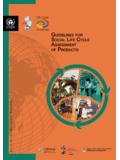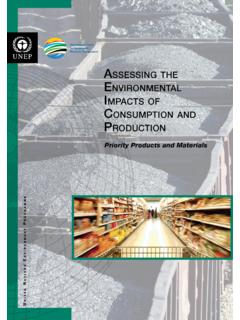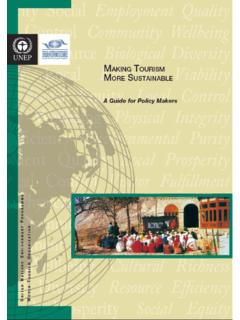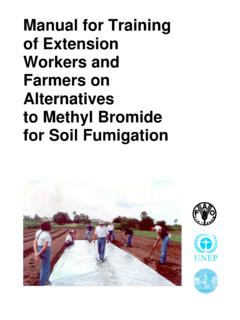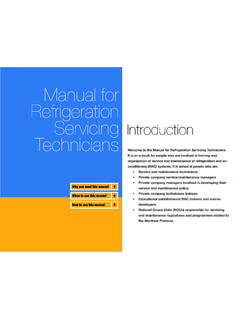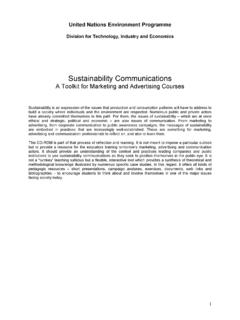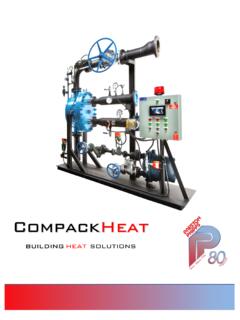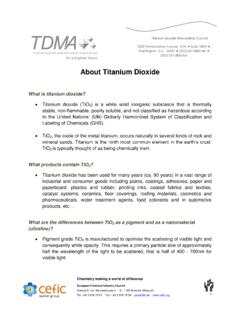Transcription of i s r a -C - UNEP
1 An introduction to their role in the context of the HCFC phase-out in developing countriesUn i t e d na t i o n s en v i r o n m e n t Pr o g r a m m einternational standards in refrigeration and air-ConditioningCopyright United Nations Environment Programme, 2014 This publication may be reproduced in whole or in part and in any form for educational or non-profit purposes without special permission from the copyright holder, provided acknowledgement of the source is made. UNEP would appreciate receiving a copy of any publication that uses this publication as a use of this publication may be made for resale or for any other commercial purpose whatsoever without prior permission in writing from the United Nations Environment designations employed and the presentation of the material in this publication do not imply the expression of any opinion whatsoever on the part of the United Nations Environment Programme concerning the legal status of any country, territory, city or area or of its authorities, or concerning delimitation of its frontiers or boundaries.
2 Moreover, the views expressed do not necessarily represent the decision or the stated policy of the United Nations Environment Programme, nor does citing of trade names or commercial processes constitute promotes environ-mentally sound practices globally and in its own activities. This publication is printed on 100% recycled paper, using vegetable -based inks and other eco-friendly practices. Our distribution policy aims to reduce UNEP s carbon document was produced by UNEP Division of Technology, Industry and Economics (UNEP DTIE) OzonAction Programme as part of UNEP s work programme under the Multilateral Fund for the Implementation of the montreal Protocol. UNEP OzonAction gratefully acknowledges the assistance of the following for reviewing and providing comments on the draft text: Mr. Urvyn Boochoon Trinidad and Tobago Bureau of standards , Implementation DivisionDr. Marissa Gowrie, National Ozone Unit, Trinidad and TobagoMr.
3 Douglas Tucker - Mitsubishi Electric US Cooling & HeatingWe are particularly grateful to Mr. Daniel Colbourne from Re-phridge Ltd for his invaluable assistance in finalising this document. The project was supervised by: Dr. Shamila Nair-Bedouelle, Head, OzonAction Branch The project was managed by: Dr. Ezra Clark, Programme Officer, OzonAction BranchMr. Ruperto de Jesus, Programme Assistant, OzonAction BranchThis was researched and written by: Ms. Jana Ma kov , consultantDr. Ezra Clark, Programme Officer, OzonAction BranchLayout and design by: Aur lie EkCredits for photos and graphics: Cover image: Indy Michael, Refrigeration and Air conditioning Engineer, Vanuatu, Michael Moller ( this image and the image on page 23 are posed photographs and do not represent actual working conditions) Background image: Jana Ma kov Acknowledgements3 The UNEP DTIE OzonAction Branch in assisting developing countries to comply with their commitments under the montreal Protocol on Substances that Deplete the Ozone Layer, particularly those related to the phase-out of hydrochlorofluorocarbons (HCFCs).
4 The alternatives to HCFCs include ozone and climate friendly alternatives such as natural refrigerants - hydrocarbons, ammonia and carbon dioxide; and lower global warming potential (GWP) HFCs, both saturated HFCs and unsaturated HFCs (HFOs). In many sectors and individual situations adoption of these alternatives is not completely straightforward, since they exhibit a range of specific properties such as flammability, toxicity and high working pressures which can limit their applicability and require special practices or approaches. standards can assist with process of application of these alternative refrigerants particularly in developing countries for enterprises that are not necessarily familiar with them and can be very useful tools to assist countries with the introduction of alternatives to ozone depleting substances and related technologies, especially from the point of view of their safe handling and preventing hazards.
5 A standard is a formal document developed by experts to ensure a certain uniform level of products and services. International, regional and national standards can provide an easily accessible mechanism and examples for nationally-applicable requirements which could be adapted/adopted in countries for alternatives to is the responsibility of each country to set up appropriate national legal measures to comply with their commitments under the montreal Protocol to phase out HCFCs and other ozone depleting substances. standards can provide the framework and insight as to how alternatives can be adopted with minimal disruption. A national consultation process may be required prior to adoption of a standard to ensure the national context is carefully evaluated in reference to existing standards and that the requirements of all relevant stakeholders are taken into in most developing countries the national ozone units (NOUs) have not been closely involved with the issue of standards .
6 As alternatives are considered and adopted better engagement with these processes is becoming increasing important and OzonAction is providing assistance to NOUs to increase their understanding of the standardisation process in general and current standards in their particular national context. Guidance is also being provided in OzonAction network meetings and information materials as to how to establish a dialogue with the relevant national standardisation bodies to ensure that the relevant standards are adopted and that these will be appropriate to the national context and support their efforts to phase-out HCFCs while adopting non-ozone depleting, low-GWP, energy-efficient alternatives. Executive summary4 NOUs should initially build their own capacity in understanding the standardisation process in their national context ShutterstockA/C Air ConditioningArticle 5 Countries operating under Article 5 of the montreal Protocol, ( developing countries)
7 ANSI American National standards InstituteAREA Air Conditioning and Refrigeration European AssociationAHRI Air-Conditioning, Heating, and Refrigeration InstituteAS Australian StandardASHRAE American Society of Heating, Refrigerating and Air-Conditioning EngineersBS British StandardBSI British standards InstitutionCEN European Committee for StandardizationCENELEC European Committee for Electrotechnical StandardizationCFC ChlorofluorocarbonDEVCO The ISO committee on developing country mattersDG Directorate GeneralDIN Deutsches Institut f r Normung Final Draft International Standard GHG Greenhouse gasGWP Global warming potentialHCFC HydrochlorofluorocarbonHC HydrocarbonHFC HydrofluorocarbonHFO HydrofluoroolefinHVAC&R Heating, ventilation, air conditioning and refrigerationIAF International Accreditation ForumIEC International Electrotechnical CommissionISO International Organization for StandardizationJSA Japanese standards AssociationNGO Non-governmental organisationNOU National Ozone UnitNSB National standardisation bodyNZS New Zealand StandardODP Ozone depleting potentialODS Ozone depleting substanceRAC Refrigeration and air-conditioning UL Underwriters LaboratoriesUNEP United Nations Environment ProgrammeUNIDO United Nations Industrial Development OrganizationWSC World standards CooperationList of Acronyms6 7 ForewordAs a result of the ongoing phase-out of hydrochlorofluorocarbons (HCFC) under the montreal Protocol on Substances that Deplete the Ozone Layer, countries - particularly developing countries are in the process of introducing alternatives to these ozone depleting substances (ODS).
8 The UNEP OzonAction Branch is assisting developing countries to comply with their commitments under the montreal Protocol, particularly those related to the HCFC phase-out, which involves a range of sectors and approaches. For the developing countries which UNEP DTIE OzonAction works with it is clear that, at present, the issue of adoption and utilisation of appropriate standards in the refrigeration and air conditioning sector is a relatively new or unknown topic for many of the National Ozone Units (NOUs). Given that many of the low-global-warming-potential (GWP) alternatives to HCFCs may have properties such as toxicity, flammability and high working pressure which the hydrochlorofluorocarbons (HCFCs) and chlorofluorocarbons (CFCs) do not exhibit, adoption of appropriate standards is one important approach that can assist in enabling the uptake of such guide is intended to provide an introduction to standards and how they can be useful in supporting the adoption of alternatives in the context of the HCFC phase-out in developing countries.
9 It also includes an overview of existing standards related to HCFCs and their alternatives, barriers to alternatives, the process of the adoption of international and regional standards at the national level, barriers to the adoption and how to overcome them. While this brief guide is principally designed as an information tool for NOUs, it should also be of interest to refrigeration associations, various government departments, including those working on standardisation issues, and other stakeholders in the refrigeration and air conditioning sector. As an NOU, armed with an understanding of the types of relevant standards , the general mechanisms and means of adoption of standards , you will be in a better position to start a dialogue with the important standardisation bodies in your country to ensure that the relevant standards are adopted and that these will be appropriate to the national context, will be beneficial and not create any barriers to particular products or practices.
10 I hope you will find this guide interesting and informative in this look forward to continue supporting your efforts to phase out HCFCs and adopting non-ozone depleting, non-global warming and energy-efficient Nair-Bedouelle PhD, HDRHead of OzonAction BranchUNEP Division of Technology, Industry and Economics8 Shutterstock AcknowledgementsExecutive SummaryList of AcronymsForeword1. Introduction2. ODS and their Alternatives3. An Introduction to Standards4. The Main Standardisation Organisations 5. Existing Standards6. Adoption of International standards at the National Level7. Final Remarks8. Further Reading and ReferencesContents346710132430405056589 Introduction1 With the phase-out of HCFCs (hydrochlorofluorocarbons) under the montreal Protocol on Substances that Deplete the Ozone Layer progressing, the introduction of alternatives with not only zero ozone depleting potential (ODP) but also low global warming potential (GWP) and improved energy efficiency is becoming an issue of increasing importance, especially in developing countries.


